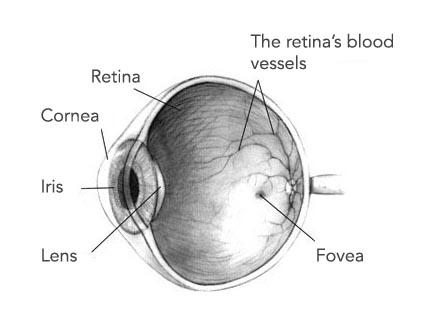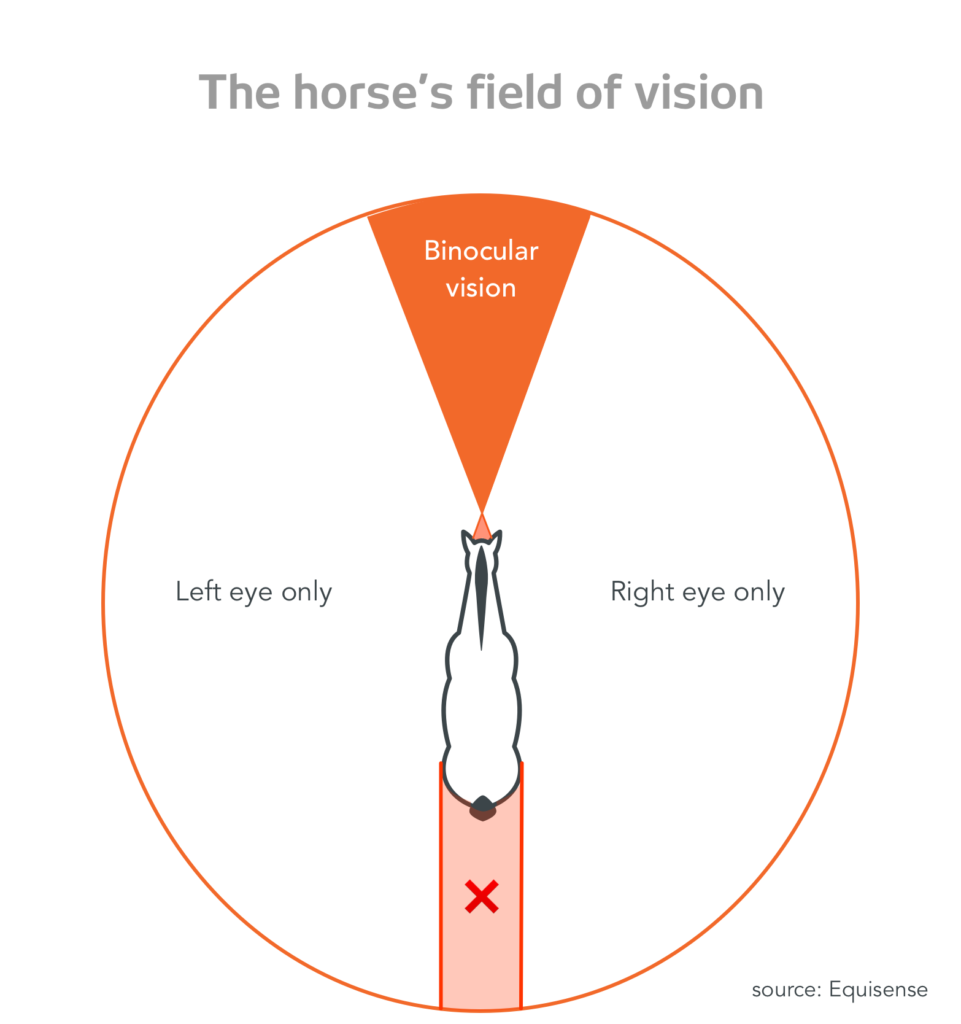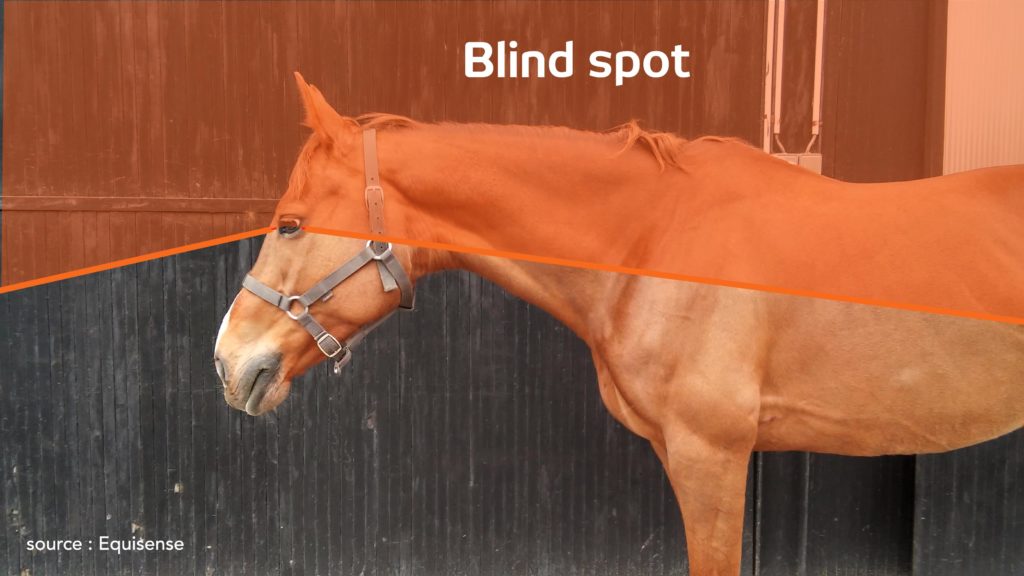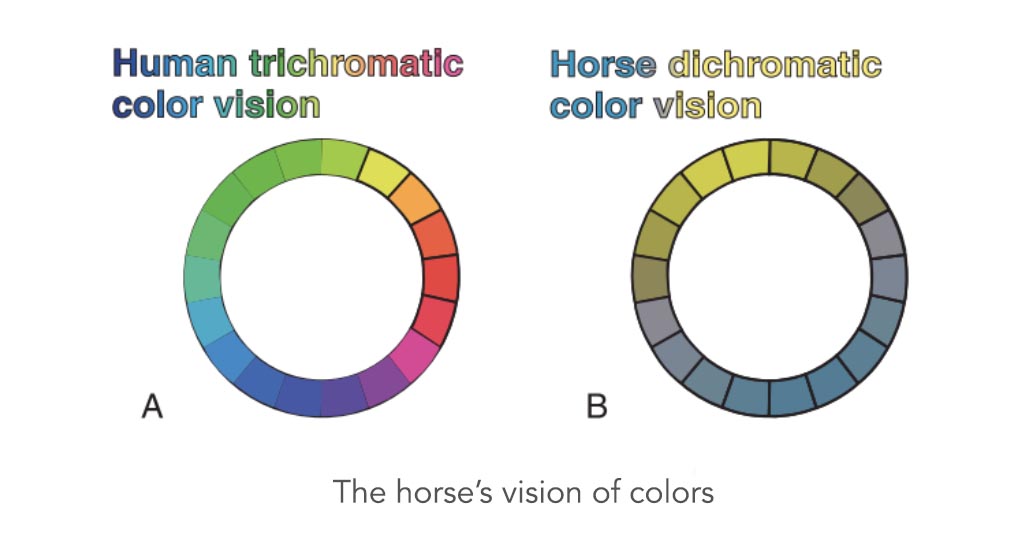
6 Questions We Ask Ourselves About Our Horse’s Sight
“My horse refused to jump another red obstacle…I tell you he doesn’t like that color! It scares him! And he keeps seeing ghosts in the woods when I’m out hacking, I think he needs glasses!” Well, how do horses see? What if I tell you that horses can’t see red and that they can see in the dark as well as cats? Let’s take a look at the horse’s vision.
Table des matières
- Question #1 – First of all, how does an eye work?
- Question #2 – What is the difference between our vision and horses vision?
- Question #3 – Can horses really see behind themselves?
- Question #4 – How do they perceive colors?
- Question #5 – Can horses see well at night?
- Question #6 – So, how to take this into account when riding ?
Question #1 – First of all, how does an eye work?
Let’s start with a little bit of anatomy.
The eye of horses is very similar to the eye of the human being in its structure.

The cornea and the eye lens work like two optical lenses that will collect the light coming from outside, concentrate it and finally form the image on the retina. The retina is actually lined with small receptors that are sensitive to different types of light. The iris, the colored part of the eye, regulates the amount of light sent to the receptors by contracting and relaxing. At this point, the image is upside down. It is sent to the brain by the optic nerve and it is the brain itself that turns the image right side up.
Question #2 – What is the difference between our vision and horses vision?
The difference between the vision of the man and the horse is twofold. The first is the shape of the pupil which is elongated and horizontal in horses. For example, it is clearly vertical in cats and round in humans. This is what allows horses to have panoramic vision.
The second is the light receptors. There are several types: rods and cones. The rods make it possible to capture an image even if there is little light, for example, they are the ones that allow us to see in a dimly lit room. But in this case, there is no color, everything is gray! If we see color, it is thanks to the cones. There are three types of cones: some capture red light, others blue light and the last ones green light. It is by associating the results of each type of cone that we see all the colours of our spectrum. The peculiarity of the horse is that the distribution of the types of receptors is not the same: the horse has no red cones (it has dichromatic vision) and more rods than humans.
Question #3 – Can horses really see behind themselves?
Almost, yes! The fact that they have their eyes on the side of their head allows them to see much better than we can on the sides and “behind” themselves.

On the right and left sides horses see with only one eye, whereas in front of them, they can see with both. However, the perception of depth is only possible in the binocular vision areas.
Experiment: close one eye and try to catch an object in front of you. Not impossible, but much more complicated than with both eyes open. You have “lost” 3D vision. Horses can only see in 3D, in a small area of about 60-65° in front of themselves.
In fact, their blind spots are under their body, in front of their nose-line, behind their croup and on an area of about 1.20m in front of their forelegs (depending on the position of their head). This means that in the last stride before an obstacle, your horse can no longer see what it has to jump!
Also, horses have “low” and horizontal vision, they don’t see above themselves, whereas we see a little above eye level. In fact, they see a bit like when you wear a cap. That’s why they raise their head strongly when they hear or see something (ghosts)!

Question #4 – How do they perceive colors?
Well, horses have a dichromatic vision as I explained above. They don’t see red.
This is actually also a form of color blindness as it disrupts all color perception. Horses will see everything in a “pastel” version and in shades of brown, yellow, blue and grey. In humans this is what we would call “protanopia”. Horses would see something like this:

Question #5 – Can horses see well at night?
Yes! Horses indeed have many more rods in their eyes than humans. This implies that they can see much better than us at night, almost as well as cats! However, this can have a big disadvantage compared to cats and us, which is that they adapt much less quickly to changes in light. In their natural state these changes are slow since they are due to the sun going down, so it takes 20 to 30 minutes for horses to adapt to the dark. This means that when you try to get your horse into a float or into a dark stall, they will only see a black hole! (Not cool)
Question #6 – So, how to take this into account when riding ?
All this has, of course, consequences when riding, of which we must be aware.
Their horizontal and “low” field of vision explains why horses raise their head when they’re about to jump. Thus, a horse that is on the hand will almost only see the ground and if falsely bent then it will only see its forelegs. This makes it difficult for your horse to jump and there is even a risk that your horse will make an error at the obstacle.
Thus, when your horse is on the contact during jumping it means that they will have to submit their eyesight and they will have to rely on you (their rider) to see in its place.
For riders with one-eyed horses, knowing that monocular vision disturbs 3D vision is information which needs to be taken into account at all costs. Your horse will have more difficulty estimating its distance to the obstacle. If you approach an obstacle through a curve on the side of your horse’s blindness, they may only see the obstacle at the last moment!
I hope that thanks to this article you will see more clearly (little play on words) the way that horses perceive the world, and that it will help you to better anticipate their needs and reactions.
I want to know more about the horse’s senses –> The ghosts your horse sees are real
See you soon in the next next article
Alice Martinez & Camille Saute
R&D engineers at Equisense
Bibliography
La vision chez le cheval, Pierre-Louis Toutain – http://www.cheval-iledefrance.com/wp-content/uploads/2011/01/La-vision-du-cheval.pdf
L. Marnay, La vision du cheval, Article Equipaedia, juin 2015 http://www.haras-nationaux.fr/information/accueil-equipaedia/comportement-ethologie-bien-etre/comportement-naturel/la-vision-du-cheval.html
A. Stachurska, M. Pieta, E. Nesteruk, Which obstacles are most problematic for jumping horses? Applied Animal Behaviour Science, Volume 77, Issue 3, 6 June 2002, Pages 197–207
J. Spaas, W. Helsen, M. Adriaenssens, et al., Correlation between dichromatic colour vision and jumping performance in horses, The Veterinary Journal, Volume 202, Issue 1, October 2014, Pages 166–171
P. E. Miller et C. J. Murphy, « Equine Vision », in Equine Ophthalmology, Second Edi., Elsevier, 2011, p. 397‑433.